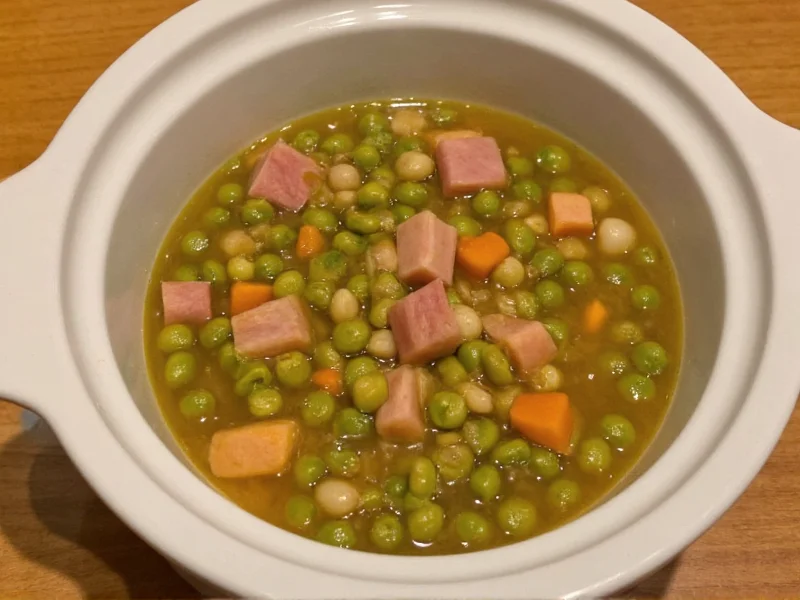There's nothing quite as comforting as a steaming bowl of split pea soup, especially when it's made effortlessly in your crockpot. This classic recipe transforms simple ingredients into a rich, creamy soup with minimal effort. The slow cooking process allows the split peas to break down naturally, creating that signature velvety texture while the ham infuses the broth with savory depth. Unlike stovetop versions that require constant attention, the crockpot method frees you to go about your day while dinner prepares itself.
Why This Crockpot Method Works Best
The magic of slow cooking split pea soup lies in the gentle, consistent heat that allows the peas to soften gradually without breaking apart too quickly. This method develops deeper flavors as the ham and vegetables slowly release their essences into the broth. You'll achieve that perfect balance of creaminess without needing dairy or thickeners—just pure, natural texture from the peas themselves.
Essential Ingredients for Perfect Split Pea Soup
Quality ingredients make all the difference in this deceptively simple soup. Don't skip these key components:
| Ingredient | Amount | Why It Matters |
|---|---|---|
| Dried green split peas | 1 pound (2 cups) | Provides the base texture and protein; green peas have better flavor than yellow |
| Cooked ham or ham hock | 1½ cups diced or 1 ham hock | Essential for smoky flavor; ham hock adds collagen for richer texture |
| Vegetable or chicken broth | 4 cups | Better flavor foundation than water; low-sodium preferred |
| Aromatic vegetables | 1 onion, 2 carrots, 2 celery stalks | Creates flavor base; should be finely diced for proper integration |
| Garlic | 3 cloves, minced | Adds depth; should be added later to prevent bitterness |
Step-by-Step Crockpot Instructions
Follow these precise steps for foolproof split pea soup every time:
- Prepare ingredients: Rinse 1 pound split peas thoroughly under cold water. Dice 1 onion, 2 carrots, and 2 celery stalks into ¼-inch pieces. Mince 3 garlic cloves.
- Layer ingredients: Place rinsed peas, diced vegetables (except garlic), 1½ cups diced ham or 1 ham hock, 4 cups broth, 1 bay leaf, and ½ teaspoon thyme into crockpot. Do not add salt yet.
- Cook slowly: Cover and cook on LOW for 6-8 hours or HIGH for 3-4 hours. The soup is ready when peas have completely broken down and texture is creamy.
- Final touches: Remove bay leaf and ham hock (if used). If using ham hock, shred meat and return to pot. Stir in minced garlic, ½ teaspoon black pepper, and salt to taste.
- Adjust consistency: For thicker soup, continue cooking uncovered for 30-60 minutes. For thinner soup, add additional broth or water.
Crockpot Settings and Timing Guide
Understanding your slow cooker's behavior ensures perfect results:
- Low setting (170-200°F): Ideal for 6-8 hours cooking. Produces creamier texture with better flavor development.
- High setting (200-220°F): Use for 3-4 hours when short on time. Check periodically to prevent over-thickening.
- Doneness test: Soup should coat the back of a spoon and peas should be completely broken down with no grainy texture.
- Overnight cooking: Safe for up to 10 hours on LOW setting without quality loss.
Avoid These Common Crockpot Mistakes
Even experienced cooks make these errors with split pea soup:
- Adding salt too early: Salt prevents peas from softening properly. Always add after peas are tender.
- Overfilling the crockpot: Never fill beyond ⅔ capacity to allow for proper circulation and prevent boil-overs.
- Stirring too frequently: Opening the lid releases heat and extends cooking time. Limit lid openings to necessary checks.
- Using old split peas: Peas older than 1 year may never soften properly. Check packaging dates when possible.
Serving and Storage Recommendations
Maximize your soup experience with these professional tips:
- Serving temperature: Serve piping hot (165°F or higher) for best flavor release
- Perfect pairings: Crusty bread, cornbread, or a simple green salad complement the soup's richness
- Garnish ideas: Fresh parsley, crumbled bacon, or a dollop of sour cream add visual appeal and flavor contrast
- Refrigeration: Store in airtight container for up to 5 days; flavors improve overnight
- Freezing: Freeze for up to 3 months; leave 1-inch headspace for expansion
- Reheating: Add broth or water when reheating as soup thickens when chilled
Variations for Different Dietary Needs
Adapt this classic recipe to suit various preferences:
- Vegetarian version: Omit ham and use smoked paprika (1 teaspoon) with vegetable broth for similar smoky notes
- Lower sodium option: Use low-sodium broth and increase herbs like thyme and rosemary for flavor without salt
- Extra protein boost: Add ½ cup cooked quinoa during the last hour of cooking
- Creamier texture: Blend half the soup with an immersion blender for restaurant-quality consistency











 浙公网安备
33010002000092号
浙公网安备
33010002000092号 浙B2-20120091-4
浙B2-20120091-4